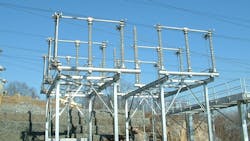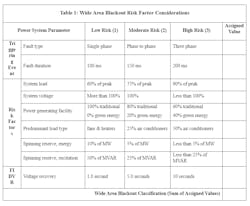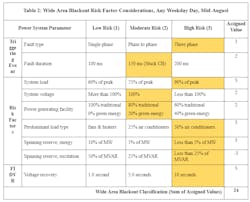Wide Area Blackouts: Predictable and Preventable
Whether caused by an attack on power grid infrastructure, a design deficiency, or human error, wide area blackouts are a threat to electric power grid reliability. They lead to disruption of everything that requires electric power to function, from industrial manufacturing and processes (water treatment, sewage treatment, natural gas pressurizing plants) to residential air conditioning and wireless internet. Part 1 of this 3-part series defines a “Blackout” and some of the prime causes that can be prevented. Part 2 and 3 will offer more examples for predicting and preventing blackouts.
The risk of wide area blackouts is a critical issue that can be addressed with risk assessments and enhancements to the existing electric power grid. But what exactly is a wide area blackout and why are they cause for concern?
Wide Area Blackouts Defined
A wide area blackout occurs when part of the electric power transmission system collapses, interrupting the flow of electric power to 250,000 customers or more. This is equivalent to shutting off electric power at 20 large neighborhood substations, leaving all the surrounding neighborhoods without power for several hours to days.
Neighborhood blackouts, when power is interrupted to 10,000 customers, and local blackouts when power is interrupted to less than 1000 customers, occur more frequently and are of less concern.
The differences key between wide area blackouts and naturally occurring power outages are that wide area blackouts are initiated by a single failure and that very few, if any, components are damaged in a wide area blackout.
Several well-known wide area blackouts have occurred, including the Northeast blackout of 1965, Northeast blackout of 2003, and Pacific southwest blackout of 2011. During these historic blackouts, power grid collapse resulted in simultaneous loss of electric power across several states.
The blackouts in 1965, 2003, and 2011 were caused by human error (lack of attention to detail). The northeast blackout of 1965 occurred when circuit breakers connected to five 230 KV transmission lines opened, sequentially, within 2 seconds. The Northeast blackout of 2003 occurred when a 345 KV transmission line sagged into trees while the power grid was experiencing low voltage. The Pacific southwest blackout of 2011 occurred when a 500 KV air break switch was opened at the wrong time
More recently, the United Kingdom blackout of 2019 occurred when two large generators tripped offline nearly simultaneously and a prolonged frequency dip occurred. This blackout was caused by a design deficiency.
Luckily, each of these blackouts required minimal repairs, and power was restored in less than 24 hours. However, this may not be the case for future wide area blackouts.
What Causes Wide Area Blackouts?
Wide area blackouts are caused by sudden mismatches between energy production and energy consumption. During normal system operation, energy produced is equal to energy consumed; this is illustrated in Figure 1, where the beam is perfectly balanced on the balance point.
When customer load slowly increases, the amount of power produced is ramped up to match energy with load. When customer load slowly decreases, the amount of power produced is ramped down to match energy with load.
Figure 2 shows power grid operations during fault conditions. When faults occur, the transfer path between energy production facilities and consumers becomes distorted. Additionally, the amount of energy transmitted from production facilities and the amount of energy required by consumers are both momentarily reduced. The amount of distortion is a function of initial conditions. Although the distortions and changes occur in much less than one second, recovery to normal operating conditions must occur in less than 10 seconds to avoid a wide area blackout.
When the initial fault is cleared, a new transfer path is established. Energy production and energy consumption are increased until a new balance point is established. At this point, there can be one of two outcomes: the grid returns to normal, balanced operating conditions; or the grid balance gets further distorted because energy consumption exceeds energy production, as shown in Figure 3.
If a new balance point is not established within 10 seconds, a wide area blackout occurs. The amount of distortion is a function of initial conditions and newly established, post-fault conditions. The 10 second window of recovery is based on a variety of independent actions. This includes actuation of motor overload protection in power plant auxiliary systems, actuation of var limiters in voltage regulators, and simultaneous reacceleration of fan, pump, and air conditioner motors in the impacted area.
Important Power System Parameters
A wide area blackout is the result of a combination of three important power system parameters: triggering events, risk factors, and voltage recovery. Let’s take a closer look at each of these three.
Triggering Events
Triggering events are tipping points that may lead to a wide area blackout. During normal system operations, energy produced by power plants, windfarms, solar farms, etc., matches energy consumed by homeowners, businesses, and industry. Occasionally, a fault will trigger a mismatch in energy production and consumption. The fault type and duration determine if the fault will trigger a wide area blackout.
A three phase fault on a high voltage facility (345 KV, 500 KV, 765 KV) is the most likely triggering event. Fault duration, the power system response to the fault, is calculated in milliseconds. On the power grid, a 100 millisecond fault is long event, and a 200 millisecond fault is a very long event. The longer the fault duration, the more likely a wide area blackout will result.
These event thresholds are based on the rotational speed of air conditioner compressor motors and the possibility of vapor lock occurring in the compressor. An 1800 RPM compressor motor completes one revolution every 33 milliseconds. A 1200 RPM compressor motor completes one revolution every 50 milliseconds.
Risk Factors
Risk factors are variables that influence recovery. Some risk factors include:
- System load: Wide area blackouts are more likely to occur during peak load conditions when many power generators are operating near their maximum ratings (above 80% of their nameplate rating).
- System voltage: Wide area blackouts are more likely to occur if system voltage is less than nominal voltage before a fault occurs.
- Type of electric power generating facility: Traditional generators have voltage controls and speed controls that can quickly increase generator voltage and power output.
- Predominant load type: Loads, such as fan motors, pump motors, air conditioner motors, and space heaters, respond differently when voltage dips occur.
- Spinning reserve, watts: Electric utilities schedule reserve power equal to the nameplate rating of the largest generator that is operating.
- Spinning reserve, excitation: Electric utilities need to provide excitation energy to each transformer, transmission line, distribution line, and motor.
Voltage Recovery
Voltage recovery is the final consideration. If all motors reaccelerate in less than one second, the power system will stabilize and continue to operate in a normal fashion. If all motors don’t reaccelerate within 20 seconds, a wide area blackout will occur.
The key is predicting when the system transfers from normal recovery to wide area blackout. The analysis of the power system between a fault and 20 seconds after a fault is fault induced delayed voltage recovery (FIDVR) analysis. Historically, FIDVR events have occurred when the predominant load is air conditioning.
Wide Area Blackout Risk Factors
Table 1 can be used to classify the risk of a wide area blackout. For each parameter, a value of 1 (low risk), 2 (moderate risk) or 3 (high risk) is entered in the assigned value column. When values in the assigned value column are summed, the likelihood of a wide area blackout is as follows:
Unlikely: Summation is less than 14
Possible: Summation is 15 to 21
Likely: Summation is 22 or more
When exact values for some parameters are difficult to ascertain, engineering judgment should be used. For example, a good rule of thumb is to assume that air conditioning is the predominant difference between light load in April and peak load in August.
Spinning reserve, energy, is evaluated based on percent of load. A large interconnected system may have a peak load of 100,000 MW and a spinning reserve requirement of 2,000 MW to cover near simultaneous loss of two 1000 MW power plants. The wide area blackout spinning reserve requirement is greater than the loss of generator spinning reserve because grid voltage dips during triggering events.
Spinning reserve, excitation, is especially difficult to ascertain. Base MVAR values are the sum of all power factor correction capacitors installed on a transmission and distribution system. For a large interconnected system, this may total 30,000 MVAR. When grid voltage dips during a triggering event, the apparent MVAR of capacitors may drop to 24,000 MVAR, while the MVAR demand may increase to 60,000 MVAR.
Assigned values are determined by assessing the VAR production and VAR capability of generators. If a 100 MVA generator with a power factor rating of 90% is operating at unity power factor, this generator can produce 31 MVAR. If this generator is supplying 20 MVAR to the power grid, the spinning reserve, excitation, is 11 MVAR. As a starting point, assume spinning reserve, excitation, is a high risk parameter.
On any given day, the probability that a triggering event will result in a wide area blackout can be estimated using the Wide Area Blackout Risk Factor Considerations in table 1. Table 2 shows hypothetical, realistic values for single day in August, when peak load is related to air conditioner usage.
Infrequent But Concerning
Wide area blackouts are infrequent, happening about once every ten years. If they are so infrequent, why are they a concern?
Disruption to essential services, business operations, and industrial production have impacts that persist for days after power is restored. Rivers and streams can be polluted when digesters at sewage treatment plants overflow. Food that thawed in restaurant freezers must be discarded and replaced. Nuclear power plants must be inspected, and limiting conditions of operation must be resolved before power production can resume.
The Northeast blackout of 2003 is estimated to have cost US$6 billion. Costs include losses in sales and manufacturing, as well as food and medication that spoiled without refrigeration. The cost to individuals is often not accounted for. When negligence is discovered, individual electric utilities face multi-million dollar civil penalties.
After the Northeast blackout of 1965, Northeast blackout of 2003, and Pacific southwest blackout of 2011, blue ribbon committees studied the event sequence, identified deficiencies, and promulgated recommendations to prevent future wide area blackouts. In our next blog, we’ll discuss triggers that will continue to challenge the reliability of the electric power grid.
About the Author
Tony Sleva
Tony Sleva, PE, LSM-IEEE is currently an adjunct instructor at the University of Wisconsin-Milwaukee, teaching continuing education courses for the power industry. He is also president of Prescient Transmission Systems. Tony has more than 50 years of professional experience as an engineering manager, electrical engineer, project manager, instructor, training program developer, forensic investigator, author, and research engineer. Tony’s T & D experience has included projects for Con Edison, Exelon, PECO, PEPCO, Atlantic City Electric, PPL, PacifiCorp, Alaska Railbelt, CTRL (Channel Tunnel Rail Link – England, France), and more. He has authored the textbook Protective Relay Principles. Connect with Tony on LinkedIn for more information.





